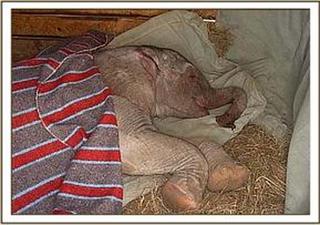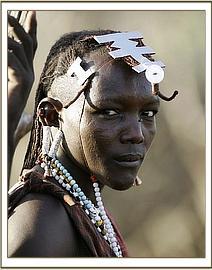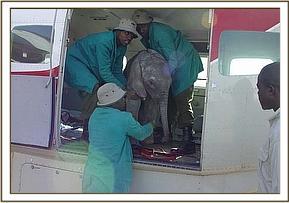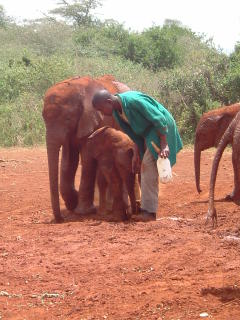Daphne Sheldrick's elephant orphanage in Nairobi- the latest addition to the family
 Now I'd like to tell you about something that is really special. Daphne Sheldrick's Elephant orphanage. Forget about these awful places called orphanages around the world where baby animals are captured and then kept in captivity all their lives. This is not the same. Baby eles are found deserted by their parents for one reason or another: poaching; washed down a river; stuck in the mud; etc. Then a team of experts fly the elephant to Nairobi national park where it is nursed back to health and with a lot of help from there keepers they are then released into the wild again at the age of 2. Baby eles are extremely similar to baby humans and this should be borne in mind while reading their stories. They grieve like us, they get sunburns like us, they need play like us, at the age of 2 an ele is still very much a toddler. They need the same love and attention that a baby does, they even get fed SMA milk!
Now I'd like to tell you about something that is really special. Daphne Sheldrick's Elephant orphanage. Forget about these awful places called orphanages around the world where baby animals are captured and then kept in captivity all their lives. This is not the same. Baby eles are found deserted by their parents for one reason or another: poaching; washed down a river; stuck in the mud; etc. Then a team of experts fly the elephant to Nairobi national park where it is nursed back to health and with a lot of help from there keepers they are then released into the wild again at the age of 2. Baby eles are extremely similar to baby humans and this should be borne in mind while reading their stories. They grieve like us, they get sunburns like us, they need play like us, at the age of 2 an ele is still very much a toddler. They need the same love and attention that a baby does, they even get fed SMA milk!Here is the story of the latest member of the family.
Narripi
There is a place, near the Tanzanian border, where the Maasai tribesmen have dug a shallow well to water their herds. It is known as "Narripi" which in the Maa dialect means "Male Guide" In the early morning of 29th August 2005,when a Maasai Warrior who is, indeed, a male guide, happened to be passing, and spotted a tiny elephant calf trapped deep inside the hole. The ground around the hole was well and truly churned up, indicative of the herds' desperate attempts to haul the baby out, but in the end, fearful of humans, they had to leave, abandoning all hope of being able to save this very precious new member of the family, who was just 3 weeks old. It was evident too that the hyenas had also found the trapped baby, and bit off the end of his trunk, as it waved helplessly in the air searching for help and his mother. The Warrior then walked to the Amboseli Park Headquarters, where he reported the fact to both the Amboseli research unit and also to the Kenya Wildlife Trust Amboseli Park authorities. The calf was extracted from the hole and The calf was extracted from the hole and left in the area in the hope that his family would return. By nightfall he was taken back to the safety of the National Park headquarters, but it was too dark for the rescue aircraft to leave Nairobi's Wilson Airport, so the Warden, who had phoned us, was advised how to proceed for the night and to let us know first thing in the morning if the calf was still alive. He said that the baby was very weak and exhausted so we told him to put a blanket over it to keep it warm, to have someone in physical contact with it throughout the night and to feed it water, but no milk, and as much water or rehydration fluid that it would take. On his own initiative, he also had a small charcoal brazier burning nearby to heat the room, which was very thoughtful, for the cold season is still upon us and he snows of Mt. Kilimanjaro are not far off. Sure enough, at first light the phone call came telling us that the calf had survived the night, that it had taken water and was a good deal stronger. He asked that it be named "Narripi" so that it would grow up to indeed become, a "Male Guide" amongst its peers. The rescue plane set off immediately, and by 9.30 a.m. on the 30th August, little "Narripi" arrived at the elephant Nursery, having been fed a bottle of weak milk mixture by our Keepers before leaving Amboseli. Upon arrival, he was given all the homeopathic pills for his injuries and his trauma, and soon afterwards, the Vet arrived to administer the injectible antibiotic which hopefully will stave off both pneumonia and septicaemia. Although in good body shape, this poor little baby's trunk is in a mess, the entire tip missing with deep bites further up as well so the pain of this wound will be intense and inhibit feeding, since a newborn elephant's trunk has to feel comfortable against the body of the mother before it will suckle - in our case, a hung blanket, or the Keepers cheek or elbow. It will be at risk from the dreaded pneumonia and, of course, having eaten copious quantities of mud and dirty water, we can expect a battle with his tummy as well. However, he is too young to feel fear, or to grieve deeply for his lost elephant family, since the hind side of his ears is still as soft as a petal, and the delicate pink of a newborn. His eyes have needed attention as well, being caked in mud, and possibly later dead tissue will have to be cut away under local anesthesia. All this presents us with the usual tough emotional challenge, but we will do our utmost to save the life of this little bull "guide" named "Narripi", who owes his life to the compassion of a Maasai Warrior, who, instead of walking away, walked 10 miles on foot to alert the Amboseli authorities of his presence.
To view the photographs from Narripi\'s rescue please click on this link:http://www.sheldrickwildlifetrust.org/asp/orphan_profile.asp?N=141
Well I've put these photos in too just in case you are too lazy.



To foster Narripi please click on this link:http://www.sheldrickwildlifetrust.org/asp/fosteringnew.asp?G=&N=141&LP=8302005458-pic7a.jpg&FN=NARRIPI
Most Sincerely,Dr. Daphne Sheldrick M.B.E. http://www.sheldrickwildlifetrust.org
Here is a picture of Lalitu, rescued by some friends of mine, sadly didn't make it due to the amount of water swallowed when washed down a river. Not all the elephants can be saved, but even these end their lives surrounded by the love of the keepers and the other babies, instead of in traumatic circumstances
 It really is the most special place. It relies totally on donations to support the work it does. You can sponsor a baby elephant and have regular updates sent to you. The orphanage is open from 11-12 every day, so if you are in Nairobi -GO THERE. It is free to go, so donate generously if you do. This orphanage not only supports the elephants, there is always a group of school children there learning about the animals which are their heritage, this is such a necessary step for Kenya to take and will ensure that conservation efforts in Kenya will eventually succeed.
It really is the most special place. It relies totally on donations to support the work it does. You can sponsor a baby elephant and have regular updates sent to you. The orphanage is open from 11-12 every day, so if you are in Nairobi -GO THERE. It is free to go, so donate generously if you do. This orphanage not only supports the elephants, there is always a group of school children there learning about the animals which are their heritage, this is such a necessary step for Kenya to take and will ensure that conservation efforts in Kenya will eventually succeed.






1 Comments:
At Wednesday, 10 May, 2006, Anonymous said…
Anonymous said…
Yes i went there last year and what a fantastic place. It really does leave a tear in your eye to see these special little babies and it is hard to leave. The keepers are so devoted to these little eles and do all they can to help with their grief of losing their mothers and families and act as surrogate families caring for them 24 hrs a day. I have a soft spot for Lualeni who was featured in the programme in 2005 on BBC1 she lost her mother and was so traumatised it really broke peoples heart to see her like that but with care and devotion in the end she managed to come round and when i went there in August she was doing great. Now i am going back to see her and the other little babies in 3 weeks i can`t wait!
Post a Comment
<< Home